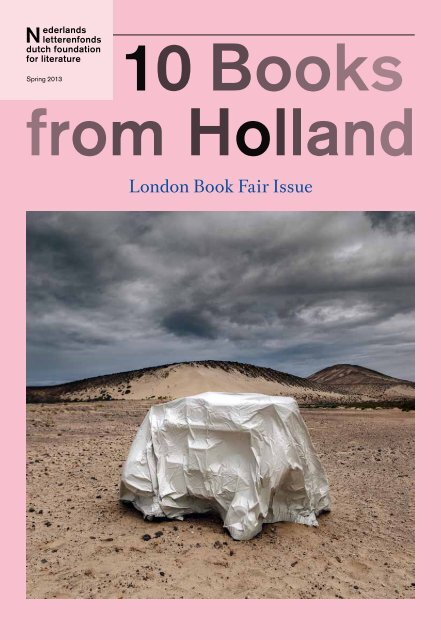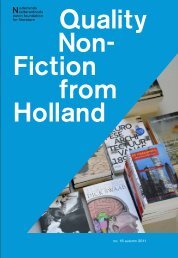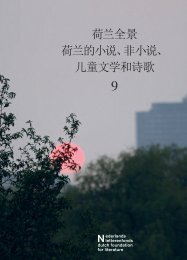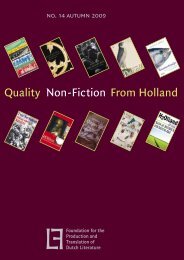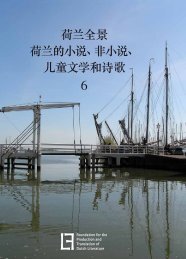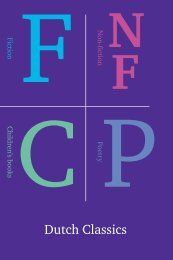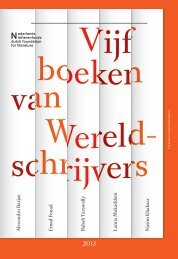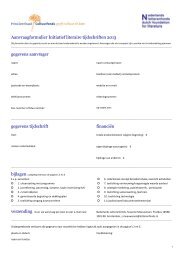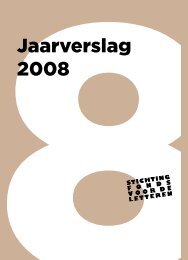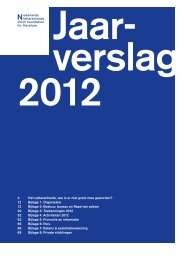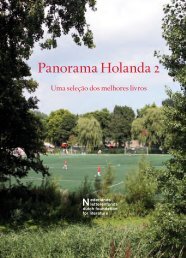10 Books from Holland - Nederlands Letterenfonds
10 Books from Holland - Nederlands Letterenfonds
10 Books from Holland - Nederlands Letterenfonds
Create successful ePaper yourself
Turn your PDF publications into a flip-book with our unique Google optimized e-Paper software.
N ederlands<br />
letterenfonds<br />
dutch foundation<br />
for literature<br />
Spring 2013<br />
<strong>10</strong> <strong>Books</strong><br />
<strong>from</strong> <strong>Holland</strong><br />
London Book Fair Issue
2<br />
<strong>10</strong> <strong>Books</strong> <strong>from</strong> <strong>Holland</strong> and Flanders<br />
The Dutch Foundation for Literature / <strong>Nederlands</strong> <strong>Letterenfonds</strong><br />
supports writers, translators and Dutch literature in translation<br />
Information<br />
The Foundation’s advisors on literary fiction,<br />
quality non-fiction, poetry and children’s and<br />
youth literature are present each year at<br />
prominent book fairs, including Frankfurt,<br />
London, Beijing and Bologna. <strong>Books</strong> <strong>from</strong><br />
<strong>Holland</strong>, Quality Non-Fiction <strong>from</strong> <strong>Holland</strong> and<br />
Children’s <strong>Books</strong> <strong>from</strong> <strong>Holland</strong> recommend<br />
highlights <strong>from</strong> each category’s selection.<br />
Translation Grants<br />
Foreign publishers wishing to publish a translation<br />
of Dutch or Frisian literature may apply for<br />
a subsidy towards the translation costs. Having<br />
acquired the rights, the publisher’s application<br />
must be accompanied by a copy of the contract<br />
with the rights owner and a copy of the contract<br />
with the translator. Application forms are<br />
available <strong>from</strong> the Foundation’s website.<br />
Subsidies are paid after receipt of complimentary<br />
copies, with printed acknowledgement of<br />
the Foundation’s support. A sample translation<br />
may be required and evaluated by our external<br />
advisors. Applications for translations that have<br />
already been published cannot be taken into<br />
consideration. Publishers looking for a qualified<br />
translator can request a list of endorsed<br />
translators for their language area.<br />
Illustrated <strong>Books</strong><br />
In the case of illustrated children’s books and/or<br />
graphic novels, foreign publishers can apply for<br />
assistance to cover a portion of the production<br />
costs. Subsidies are jointly funded by the<br />
Mondrian Foundation and the Dutch Foundation<br />
for Literature.<br />
Promotional travel<br />
The Foundation is able to support a publisher<br />
wishing to invite an author for interviews or<br />
public appearances. Literary festivals are<br />
likewise eligible for support. Additionally, the<br />
Foundation organizes international literary<br />
events in co-operation with local publishers,<br />
festivals and book fairs.<br />
Writers-in-residence<br />
The Foundation coordinates writer-in-residence<br />
programmes together with foreign universities<br />
and institutions. International authors are invited<br />
to spend time working in Amsterdam. They may<br />
stay one or two months at the writers’ lodgings<br />
above the Athenaeum <strong>Books</strong>hop on the Spui (in<br />
co-operation with the Amsterdam Fund for the<br />
Arts).<br />
International visitors programme<br />
The visitors programme and the annual<br />
Amsterdam Fellowship offer publishers and<br />
editors the opportunity to acquaint themselves<br />
with the publishing business and the literary<br />
infrastructure of the Netherlands.<br />
Translators’ House<br />
The Translators’ House offers translators the<br />
opportunity to live and work in Amsterdam for<br />
a period of time. It is involved with numerous<br />
activities assisting and advancing translators’<br />
skills. Each year the Literary Translation Days<br />
are held for those translating into and <strong>from</strong><br />
Dutch.<br />
Schwob: discovering international classic<br />
works of fiction<br />
Schwob draws attention to and supports as-yet<br />
undiscovered, untranslated classics of world<br />
literature. Each month the editors select new<br />
titles on www.schwob.nl.<br />
Background<br />
The Dutch Foundation for Literature, created in<br />
20<strong>10</strong> as the result of the merger between the<br />
Foundation for the Production and Translation<br />
of Dutch Literature (NLPVF) and the Foundation<br />
for Literature (FvdL), is an independent organization<br />
financed by the Ministry of Education,<br />
Culture and Science. Policies and projects are<br />
carried out in co-operation with the Flemish<br />
Literature Foundation.<br />
Interested in receiving our newsletter? Send<br />
your request to post@letterenfonds.nl or sign<br />
up on www.letterenfonds.nl.<br />
Dutch Foundation<br />
for Literature<br />
Nieuwe Prinsengracht 89<br />
<strong>10</strong>18 VR Amsterdam<br />
Tel. +31 20 520 73 00<br />
Fax +31 20 520 73 99<br />
The Netherlands<br />
post@letterenfonds.nl<br />
www.letterenfonds.nl<br />
Advisors Fiction<br />
Barbara den Ouden: Eastern and<br />
Middle Europe, Mediterranean<br />
countries, Russia, Scandinavia<br />
b.den.ouden@letterenfonds.nl<br />
Victor Schiferli: French, German<br />
and English-language countries<br />
v.schiferli@letterenfonds.nl<br />
Pieter Steinz: Africa, Arabicspeaking<br />
countries, Asia,<br />
Israel, Latin-America<br />
p.steinz@letterenfonds.nl<br />
Schwob<br />
Alexandra Koch<br />
a.koch@letterenfonds.nl
3<br />
Tommy Wieringa<br />
These Are the Names<br />
<strong>10</strong> <strong>Books</strong> <strong>from</strong> <strong>Holland</strong><br />
A fascinating, dark novel about alienation and migration<br />
‘To discard one’s old soul, that frayed,<br />
worn thing, and get a new one in its place.<br />
Who wouldn’t want that?’ This is Pontus<br />
Beg speaking, the police commissioner of<br />
Michailopol, a drab city in the Russian<br />
steppes. He is a melancholy cynic, a<br />
philosopher who is all too aware of the<br />
meaninglessness of life, but when he<br />
comes into contact with a group of<br />
refugees, his life takes an unexpected<br />
turn.<br />
Tommy Wieringa, who garnered international<br />
praise with two novels full of vital<br />
energy: Joe Speedboat and Caesarion,<br />
employs a raw and sober tone in his new<br />
novel. The atmosphere is reminiscent of<br />
Coetzee’s Waiting for the Barbarians,<br />
Cormac McCarthy’s The Road and Isaak<br />
Babel’s short stories. We follow two parallel<br />
storylines: that of the solitary policeman,<br />
and that of the refugees on their hopeless<br />
quest through a barren and desolate<br />
landscape.<br />
The group of refugees are given neither<br />
names nor faces. They are taken over a<br />
border under false pretences, and told to go<br />
west until they reach a city. An internal<br />
conflict begins within the group, which<br />
flares up as the city fails to appear and their<br />
wanderings take longer and longer. Finally<br />
the company arrive in Michailopol. The<br />
group of refugees look so frail and emaciated,<br />
the inhabitants take them for dead<br />
people risen up <strong>from</strong> their graves.<br />
Then the dead body of a rabbi is found in<br />
the city. Pontus Beg’s investigations lead<br />
him to another rabbi, who initiates him<br />
into the laws and history of Judaism. It is<br />
clear he will have to abandon some of his<br />
cynicism and gradually his loneliness<br />
subsides as he comes to realise that he<br />
belongs to a people who have been running<br />
for their whole lives, the Jews. ‘We’re a<br />
braided rope, separate threads which<br />
together make a cord. It’s how we are<br />
connected. What binds us is what we are.’<br />
The story of the police commissioner<br />
investigating the murder of the rabbi ends<br />
up merging with that of the refugees. Their<br />
story in turn resonates with the book of<br />
Exodus: hunger and despair, mystical codes<br />
and the power of believing that a higher<br />
force will lead them to the promised land.<br />
These Are the Names is a poetic parable<br />
about the fate of peoples adrift in the<br />
twenty-first century, a story which, despite<br />
all its darkness, still seems to offer hope.<br />
Publishing details<br />
Dit zijn de namen (2012)<br />
304 pp., ca. 70.485 words<br />
90,000 copies sold<br />
Rights<br />
De Bezige Bij<br />
www.debezigebij.nl<br />
Marijke Nagtegaal,<br />
m.nagtegaal@debezigebij.nl<br />
Hayo Deinum,<br />
h.deinum@debezigebij.nl<br />
Rights Sold<br />
Portobello (UK), Hanser (Germany),<br />
Iperborea (Italy), Actes Sud (France)<br />
Other Translated Titles<br />
Please see www.letterenfonds.nl/<br />
en/authors-and-translators/<br />
English Sample Translation<br />
Available<br />
Tommy Wieringa (b. 1967) is the author of<br />
Alles over Tristan (Everything About Tristan,<br />
2002) and the book which propelled his<br />
breakthrough to a wide audience, Joe<br />
Speedboat (2005, 300.000 copies sold).<br />
His travel stories were collected in Ik was<br />
nooit in Isfahaan (I Never Went to Isfahan,<br />
2006). In 2007, De dynamica van begeerte<br />
(The Dynamics of Desire) was published, a<br />
study into the origins of desire and the major<br />
role of pornography in the modern world.<br />
Tommy Wieringa’s works have been translated<br />
all over the world, into languages like<br />
Hebrew, Korean, French, German and<br />
English. Dit zijn de namen has been shortlisted<br />
for this year’s Libris Literatuurprijs.<br />
‘This is a landmark<br />
novel which, alongside<br />
intelligence, discipline<br />
and originality, also<br />
shows Wieringa’s lust<br />
for perfection.’<br />
— de Volkskrant<br />
‘Wieringa leaves no doubt<br />
as to what it is about –<br />
what people believe.<br />
Everything revolves<br />
around the meaning they<br />
give to events. An<br />
unusually clever novel.’<br />
— NRC Handelsblad<br />
Photo: Johan Jacobs
4<br />
Oek de Jong<br />
Pier and Ocean<br />
<strong>10</strong> <strong>Books</strong> <strong>from</strong> <strong>Holland</strong><br />
An expansive family history set against the backdrop<br />
of post-war reconstruct<br />
In this monumental novel, Oek de Jong<br />
tells the story of Dina Houttuyn and her<br />
son, Abel Roorda. He shows that no one<br />
is born without a history and that our<br />
lives are influenced by those of our<br />
parents and ancestors. This portrayal of<br />
the still sober mentality of the post-war<br />
Netherlands is painted in a evocative<br />
style, with strong, atmospheric scenes.<br />
The novel begins with a pregnant Dina’s<br />
flight <strong>from</strong> the southern provincial town<br />
where her husband has been doing his<br />
military service. One morning she comes<br />
across her landlady half-naked and flees<br />
north, to Amsterdam, shocked by her own<br />
reaction. Through a series of flashbacks,<br />
we learn what has turned her into the<br />
woman who will become Abel’s mother in<br />
part two.<br />
Housed with a Frisian pastor’s family<br />
during the war, she falls in love with one<br />
of the son’s friends. Four years later she is<br />
pregnant. It is almost a deliberate choice<br />
to put an end to her uncertainty about her<br />
sexual orientation, which first came to<br />
light in the orphanage where she worked<br />
after the war. She was happy there, glad to<br />
escape her parents’ clutches. That happiness<br />
came to an end though, when the<br />
matron, Elena, fell in love with her and<br />
seduced her.<br />
Dina finally grows accustomed to life<br />
with a narcissistic husband who does not<br />
understand her. Abel sees his mother as a<br />
conflicted woman who feels trapped <strong>from</strong><br />
all sides but powerless to free herself. His<br />
father’s vanity does not escape him either.<br />
With an adolescent indifference, he rebels,<br />
searching for freedom.<br />
Abel’s first infatuations, his cool, distant<br />
friendships, his mooching around during<br />
endless summer holidays – all these scenes<br />
seem to echo De Jong’s masterful debut<br />
Opwaaiende zomerjurken (Billowing<br />
Summer Dresses, 1979). The sensuousness<br />
with which its protagonist, Edo Mesch,<br />
observes the world is shared by Abel, who<br />
can feel and smell the difference between<br />
Frisian and Zeeland soil.<br />
Pier and ocean, a reference to a series of<br />
paintings by Mondrian, seems to stand for<br />
this struggle: breaking free of social and<br />
familial bonds and striving for independence.<br />
While Abel seems to reach the ocean,<br />
Dina clings eternally to the pier.<br />
Publishing Details<br />
Pier en oceaan (2013)<br />
804 pp., 253,000 words<br />
Rights<br />
Atlas Contact<br />
www.atlascontact.nl<br />
Uta Matten,<br />
umatten@atlascontact.nl<br />
Elaine Michon,<br />
emichon@atlascontact.nl<br />
See also<br />
www.oekdejong.nl<br />
Sample Translation Available<br />
Oek de Jong (b. 1952) broke through in<br />
1979 with his debut novel Opwaaiende<br />
zomerjurken (Billowing Summer Dresses).<br />
Over fifteen months, the novel was reprinted<br />
nineteen times and sold 95,000 copies. He<br />
confirmed his status as one of the<br />
Netherland’s top authors with the philosophical<br />
and equally successful novel Cirkel in het<br />
gras (Circle in the Grass,1985) and the<br />
tragic portrait of a woman, Hokwerda’s kind<br />
(Hokwerda’s Child, 2002). Pier and Ocean<br />
has been shortlisted for both the Libris<br />
Literature and the Boekenuil prizes.<br />
‘You see the photos, you<br />
look at the pictures and the<br />
sensitive reader guesses at,<br />
feels and sees the churning<br />
underneath.’ — Het Parool<br />
‘Oek de Jong’s magnum<br />
opus. A magnificent<br />
evocation of lost times.’<br />
— NRC Handelsblad<br />
‘Without doubt, Oek de<br />
Jong’s crowning<br />
achievement.’ — Trouw<br />
Photo: Koos Breukel
5<br />
<strong>10</strong> <strong>Books</strong> <strong>from</strong> <strong>Holland</strong><br />
Oek de Jong<br />
Billowing Summer Dresses<br />
The classic 1979 breakthrough novel:<br />
a young man in search of harmony<br />
This is one of those books which meet with<br />
success upon publication and remain<br />
successful ever after. The story follows the<br />
development of Edo Mensch <strong>from</strong> childhood<br />
to adolescence to adulthood.<br />
He is a bundle of contradictions: he looks<br />
for love, but walks away when it comes too<br />
close. He wants to feel but constantly<br />
rationalizes. He strives for naturalness but<br />
is artificial through and through. The crux<br />
of the matter is a search for harmony, the<br />
harmony he remembers <strong>from</strong> sitting on the<br />
back of his mother’s bike during a cycle ride,<br />
the soughing of the wind, the billowing of<br />
skirts. It gives him an ‘indescribable feeling<br />
of light and space’.<br />
Finally all is well: ‘Everything was just as<br />
it was. But he belongs everywhere and<br />
floats.’ In the end, Edo chooses to live in a<br />
world of his own imagination, removed<br />
<strong>from</strong> the one he had inhabited before.<br />
Publishing Details<br />
Opwaaiende zomerjurken (1979)<br />
271 pp., 88,000 words<br />
200,000 copies sold<br />
Rights sold<br />
Germany (Piper), France (Gallimard),<br />
Swedish (Norstedts) and Arabic<br />
(Dar-Al-Adab)<br />
‘This first novel is, in its<br />
style and control of<br />
language, a peak in the<br />
tradition of individualistic<br />
and autobiographical<br />
literature.’<br />
— NRC Handelsblad<br />
Oek de Jong<br />
Hokwerda’s Child<br />
A darkly scintillating romance:<br />
the psyche of a female murderer<br />
This psychological novel is narrated with<br />
a broad vision yet an extraordinary eye for<br />
detail. The novel opens with an oppressive<br />
scene: as a young girl, Lin is repeatedly<br />
thrown into the river by her father. Every<br />
time, after splashing hard into the water,<br />
she swims back to him. Yet time and again<br />
she is flung back – until she almost<br />
drowns.<br />
The shadow of this scene hangs over the<br />
entire book. In her twenties, after a<br />
successful but prematurely interrupted<br />
sporting career, Lin meets the man of her<br />
dreams. But the pattern of their love<br />
resembles that of the opening scene: Lin is<br />
consistently cast away by Henri but always<br />
comes back. When she meets Jelmer, a<br />
mild-mannered lawyer, it appears that she<br />
can eradicate the fatal figure <strong>from</strong> her life.<br />
However, she cannot quieten her restlessness<br />
and seeks out Henri once more.<br />
De Jong allows his characters to attain<br />
great heights of love in sensual, erotic<br />
scenes, which cause the reader to momentarily<br />
forget the sense of menace. Finally<br />
he transports Lin and Henri with great<br />
stylistic power to the ‘outer darkness’<br />
and their inevitable downfall.<br />
Publishing details<br />
Hokwerda’s kind (2002)<br />
444 pp., 170,000 words<br />
<strong>10</strong>0,000 copies sold<br />
Rights sold<br />
France (Gallimard), Danmark<br />
(Gyldendal), Germany (Piper)<br />
‘You feel as if you are really<br />
getting to know them both<br />
and, in all their challenges<br />
and tensions, you begin to<br />
see a love which is true,<br />
sometimes even pure, and<br />
which makes everything<br />
right in a most confusing<br />
fashion.’<br />
— NRC Handelsblad
6<br />
Stefan van Dierendonck<br />
And It’s Raining Bread<br />
<strong>10</strong> <strong>Books</strong> <strong>from</strong> <strong>Holland</strong><br />
An impressive debut novel about a fatal collision with faith<br />
Stefan van Dierendonck has written a<br />
debut novel with an improbable story<br />
actually based on the true fact of a young<br />
priest with an allergy to the Eucharist.<br />
The church, right up to the Vatican,<br />
refuses to adapt the hosts for the main<br />
character. The writer has used own<br />
experiences to compose an unusual and<br />
intelligent story, which unsettles and<br />
raises important questions.<br />
The novel has a classical story-within-astory<br />
structure. An elderly father has a<br />
meeting with the monastery’s abbot one<br />
morning. The abbot gives him a box left<br />
behind by Clemens Driessen, an apprentice<br />
priest who died young in unclear circumstances.<br />
He returns to his monastery cell to<br />
commit young Clemens’s life to paper.<br />
Van Dierendonck skillfully builds up the<br />
tension and tells how this small boy was<br />
impressed by the grandeur of a cathedral<br />
his father took him to. When his father<br />
mentions in passing that Jesus lodges in<br />
your heart when you eat the hostand<br />
remains there until you commit your first<br />
sin, his life becomes an exhausting battle to<br />
remain pure.<br />
He avoids his peers and keeps his piety<br />
secret – he plays Marian hymns on his<br />
Walkman and carries a rosary in his pocket.<br />
He walks away <strong>from</strong> the only girl he falls in<br />
love with because of his calling. Clemens is<br />
clearly planning on hanging onto Jesus for<br />
as long as he can. Then fate strikes and his<br />
father dies when they are out jogging<br />
together.<br />
He enrols in a seminary but things go<br />
wrong there too. Clemens is assaulted by a<br />
fellow student and his supervisors fail to<br />
react. He feels estranged <strong>from</strong> the churchgoers<br />
who scarcely believe in anything<br />
anymore but are happy to receive the host<br />
he gives them. He must preach things<br />
without agreeing with them. He feels like<br />
an actor.<br />
And to make matters worse, he turns out<br />
to have a gluten intolerance: ‘Imagine this:<br />
I’m ill. The holy bread has made me ill. God<br />
has made me ill.’ After long insistence, the<br />
church comes up with an apparent solution:<br />
gluten-free hosts. They still make him<br />
ill, but it is a cross he has to bear.<br />
In the end, Clemens opts to take his own<br />
life, but even in his darkest hour, he<br />
continues to consider others. And It’s<br />
Raining Bread is a book which questions<br />
the role we give religion in our lives and<br />
shows how adhering to rules can lead to us<br />
losing, rather than finding ourselves.<br />
Publishing Details<br />
En het regende brood (2012)<br />
249 pp., ca. 60.000 words<br />
Rights<br />
Thomas Rap<br />
www.debezigebij.nl<br />
Marijke Nagtegaal,<br />
m.nagtegaal@debezigebij.nl<br />
Hayo Deinum,<br />
h.deinum@debezigebij.nl<br />
English Sample Translation<br />
Available<br />
‘Stefan van Dierendonck<br />
really impressed me<br />
with this harrowing,<br />
autobiographical book.<br />
The disconcerting story<br />
of this young, passionate<br />
former priest is surprisingly<br />
well-written and makes<br />
clear that a shining future<br />
awaits him outside the<br />
Catholic church.’<br />
— Jan Siebelink, author<br />
of In My Father’s Garden<br />
Stefan van Dierendonck (b. 1972) served<br />
as an altar boy <strong>from</strong> age eight in a church in<br />
Brabant and later attended the seminary in<br />
Den Bosch. He has now left the priesthood<br />
to become a writer. His debut novel was<br />
warmly received and reprinted several times<br />
after the novel’s controversial subject matter<br />
led to the author’s successful appearance on<br />
a very popular talk show.<br />
‘Van Dierendonck's style<br />
is vitriolic, precise and<br />
funny, his debut as a<br />
novelist is a real pleasure<br />
to read.’ – Vrij Nederland<br />
‘A beautiful, semiautobiographical<br />
debut.<br />
Subtle and convincing.’<br />
– Trouw<br />
Photo: Keke Keukelaar
7<br />
Hanna Bervoets<br />
Everything There Was<br />
<strong>10</strong> <strong>Books</strong> <strong>from</strong> <strong>Holland</strong><br />
A post-apocalyptic novel about human behaviour<br />
in a state of emergency<br />
In the reality TV show Big Brother,<br />
people were voluntarily locked up in a<br />
house and filmed. This may well have<br />
been the inspiration for the new novel by<br />
writer and columnist, Hanna Bervoets,<br />
in which a group of eight people gather in<br />
a school building to record a TV programme<br />
about science. A brilliant young<br />
boy with a talent for maths is being<br />
interviewed for the show.<br />
During the recordings, a huge explosion is<br />
heard outside. Afterwards all they can see<br />
<strong>from</strong> the windows is a thick mist; no one<br />
knows what’s happened. They turn on the<br />
television and are instructed to seal off all<br />
openings and cracks in the building. The<br />
people soon begin to adapt to the ‘new<br />
situation’, but no one knows what fate has<br />
in store for them.<br />
The novel is made up of the nonchronological<br />
diary entries of Merel, one<br />
of the production crew. She keeps a diary<br />
about the events following the bang and<br />
because she is the only source of information,<br />
the reader doesn’t always know<br />
whether to trust her.<br />
To make things more complicated, her<br />
entries are not in the right order – which<br />
might suggest that we are reading the<br />
loose pages of a manuscript found after<br />
the culmination of events. The coolness<br />
with which she keeps a record stands in<br />
stark contrast to the state the world is in.<br />
In addition, she casually mixes high and<br />
low culture. In the face of death, there’s<br />
little difference between Norbert Elias’s<br />
writings and the Burger King menu.<br />
Tension mounts as the characters’<br />
situation becomes more and more perilous.<br />
One by one, the characters begin to<br />
leave the stage. People become mistrustful.<br />
Merel already realizes quite early on that ‘it<br />
doesn’t matter what you do. It matters<br />
what people think you do.’ The essence of<br />
the novel is the fight for survival, right up<br />
to the chilling end.<br />
Publishing details<br />
Alles wat er was (2013)<br />
283 pp., 63,520 words<br />
Rights<br />
Atlas Contact<br />
www.atlascontact.nl<br />
Uta Matten,<br />
umatten@atlascontact.nl<br />
Elaine Michon,<br />
emichon@atlascontact.nl<br />
English Sample Translation<br />
Available<br />
‘In Bervoet’s work, in her<br />
novels and columns, her<br />
tone is always light and<br />
modern, she is clearly<br />
rooted in the present day.<br />
Her sentences are not<br />
sensitive or poetic, but<br />
functionally carefree. They<br />
ring with self-confidence.’<br />
— de Volkskrant<br />
Hanna Bervoets (b. 1984) is a writer,<br />
columnist and journalist. She is the author of<br />
a popular column in the broadsheet, de<br />
Volkskrant, and has written for various<br />
newspapers and magazines. Her novelistic<br />
debut Of hoe waarom (Or How Why, 2009)<br />
was followed by the winner of the OPZIJ<br />
Literature Prize Lieve Céline (Dear Céline,<br />
2011).<br />
‘If there’s light at the end<br />
of the tunnel, it’s probably<br />
just wishful thinking.<br />
Eat or be eaten, that’s the<br />
great question in this<br />
uncompromising work<br />
of art.’<br />
— De Groene<br />
Amsterdammer<br />
Photo: Stefan Vanfleteren
8<br />
Pieter Waterdrinker<br />
Lenin’s Balsam<br />
<strong>10</strong> <strong>Books</strong> <strong>from</strong> <strong>Holland</strong><br />
An adventure story about the pursuit of beauty,<br />
money and love in the crumbling Soviet Union<br />
Lenin’s Balsam describes a young man’s<br />
animated search for a mysterious cream.<br />
The story takes place in Russia in the<br />
period immediately following the Cold<br />
War when fortune hunters and profiteers<br />
made their move.<br />
Moscow 1990. Lawyer and orphan, Olaf<br />
Weber, makes a lot of money on the black<br />
market and by conning tourists. Then he<br />
meets the charming scoundrel, Alexander<br />
Perelman, who tells him that the balsam<br />
used to preserve Lenin’s body also makes<br />
wrinkles disappear. Eternal youth and<br />
immeasurable riches are within hand’s<br />
reach. Olaf must find out what the ingredients<br />
are and invest in the project.<br />
During his search for the balsam’s<br />
secret formula, colourful figures pass<br />
review, such as Ivan the Nose, Ivan the<br />
Chin, perfume expert Maurice Maupassant<br />
and master embalmer Abrikosov. The<br />
quest begins at Lenin’s mausoleum and<br />
leads <strong>from</strong> Siberia to Vinnitsa in the<br />
Ukraine. There, with the help of his<br />
great-aunt Felicia, Olaf manages to find<br />
the formula and keep it out of the hands of<br />
an armed cleric who has been following<br />
him for months.<br />
The recipe turns out to be simple, but<br />
completely useless: the balsam doesn’t<br />
work on living people. Olaf finds happiness,<br />
not in business, but through his love<br />
for the beautiful Masha. They move to<br />
France together where he becomes a<br />
writer.<br />
Nothing is what it seems in this picaresque<br />
novel: the conman gets conned, the<br />
lovely lady who talks about orgies is still a<br />
virgin and Aunt Felicia turns out to have<br />
been Jewish all along.<br />
But there is no ambiguity about the<br />
essential matters: the destructive influence<br />
of 20th century ideologies, the importance<br />
of parental love, and the author’s compassion<br />
for characters who strive after an<br />
independent existence under their control.<br />
Lenin’s Balsam is an ode to freedom and<br />
love, a compelling and moving novel about<br />
an orphaned folk and a nation adrift.<br />
Publishing Details<br />
Lenin’s balsem (2013)<br />
400 pp., 120,902 words<br />
Rights<br />
Prometheus<br />
www.pbo.nl<br />
Denise Larsen, d.larsen@pbo.nl<br />
Translated Titles<br />
The German Wedding<br />
(Duitse bruiloft). Atlantic <strong>Books</strong>,<br />
2009. Also in German (Aufbau,<br />
2007).<br />
English Sample Translation<br />
Available<br />
Pieter Waterdrinker (b. 1961) lives by turns<br />
in Moscow and Saint Petersburg. He has<br />
unparalleled knowledge of modern Russia,<br />
and his habitat always plays a principal role in<br />
his work. In 1998, he made his debut with the<br />
novel Danslessen (Dancing Lessons) which<br />
received immediate acclaim. This was<br />
followed by the novels Liebmans Ring and<br />
Een <strong>Holland</strong>se romance (A Dutch Romance)<br />
and the collection of short stories entitled<br />
Montagne Russe. His major breakthrough<br />
came with the novel Duitse bruiloft (The<br />
German Wedding) which was translated into<br />
English, German and Russian, and was<br />
nominated for the Gerard Walschap Prize<br />
and will be made into a movie. His penultimate<br />
novel De dood van Mila Burger (The<br />
Death of Mila Burger) is being adapted as a<br />
Russian opera.<br />
‘A book with an exotic<br />
elegance.’ — de Volkskrant<br />
‘A hilarious quest, written<br />
in a wonderful baroque<br />
style.’ — De Telegraaf<br />
Photo: Julia Klotchkova
9<br />
Saskia Goldschmidt<br />
The Hormone Factory<br />
<strong>10</strong> <strong>Books</strong> <strong>from</strong> <strong>Holland</strong><br />
The history of a multinational corporation in a thrilling novel<br />
about sex addiction and the abuse of power<br />
In her debut as a novelist, Saskia Goldschmidt<br />
has chosen the true story of two<br />
brothers and a scientist who set up a<br />
pharmaceutical factory in the years<br />
running up to the Second World War.<br />
The author transforms this story into a<br />
tragedy of biblical proportions, with<br />
hormones flying all over the place.<br />
Main character – and unreliable narrator<br />
– is the 97-year-old Mordechai (‘Motke’)<br />
de Paauw, a former conman and womanizer<br />
who is looking back on his life <strong>from</strong><br />
his deathbed. ‘A coach and horses could<br />
drive through the gaps in my conscience,’<br />
he says at the beginning, while his twin<br />
brother Aron’s high moral stance led him<br />
‘right into the abyss’.<br />
Next comes a picaresque account of the<br />
rise of the factory in the southern part of<br />
the country. We learn how Motke and<br />
Aron, with the help of a vain scientist,<br />
isolated hormone preparations <strong>from</strong> offal.<br />
How the brothers were driven apart by<br />
Motke’s haggling, his loose morals and,<br />
finally, a scurrilous plan. How the company<br />
survived the war while Aron died in a<br />
concentration camp. And how Motke<br />
picked up his carefree life again after the<br />
war – but is now heading for a resentful<br />
and unhappy death.<br />
Told at a fast pace, packed with colourful<br />
vignettes of daily life in the twentieth<br />
century, The Hormone Factory offers a<br />
fascinating insight into the ruthlessness of<br />
businessmen or, as Motke says himself:<br />
the men who know what it means to<br />
sacrifice their own lives and those of their<br />
loved ones for a large business.<br />
Motke is neither subtle nor sympathetic,<br />
but his candid voice and his unhypocritical<br />
approach to life make him a<br />
character you won’t soon forget. This is<br />
clear <strong>from</strong> the first page, when he says,<br />
‘Yes, I have left my mark. But whether that<br />
helped the world? In avoiding the rain, we<br />
stumble into a ditch. We do nothing more,<br />
none of us.’<br />
Publication details<br />
De hormoonfabriek (2012)<br />
285 pp., 82,000 words<br />
Rights<br />
Cossee<br />
www.cossee.com<br />
Eva Cossee,<br />
cossee@cossee.com<br />
Rights sold<br />
France (Gallimard), Germany (DTV),<br />
USA (The Other Press)<br />
Full English Translation<br />
Available<br />
Saskia Goldschmidt (b. 1954) worked as a<br />
youth theatre producer and trainer of hospital<br />
staff and debuted in 2009 with Verplicht<br />
gelukkig (Compulsory Happiness), an<br />
autobiographical non-fiction book about<br />
growing up in the shadow of the Holocaust.<br />
The success of her debut and the discovery<br />
of documents about the rise of the pharmaceutical<br />
giant Organon (producers of the<br />
contraceptive pill), prompted her to write this<br />
novel. The Hormone Factory was an instant<br />
success in the Netherlands and rights have<br />
already been sold to Germany, Israel and the<br />
United States.<br />
‘A gripping story in which<br />
the birth of modern<br />
medical science, the<br />
post-war explosion of<br />
wealth and the bargaining<br />
that goes on between<br />
science and commerce are<br />
brought together.’ —<br />
8Weekly<br />
‘Goldschmidt’s narrative<br />
style is arresting,<br />
picturesque and<br />
humorous. A gripping<br />
story, which seduces the<br />
reader with wonderful<br />
sentences.’ — Literair<br />
Nederland<br />
Photo: Krijn van Noordwijk
<strong>10</strong><br />
Thomas Rosenboom<br />
The Red Carpet<br />
<strong>10</strong> <strong>Books</strong> <strong>from</strong> <strong>Holland</strong><br />
A contemporary tragicomedy about<br />
fame and loneliness<br />
A born loser <strong>from</strong> a city in an eastern<br />
province is the protagonist of the new<br />
novel by Thomas Rosenboom, one of<br />
Dutch literature’s most refined stylists.<br />
The Red Carpet charts the life and times<br />
of a proud underachiever, ‘constantly on<br />
the move without getting anywhere.’<br />
Lou Baljon’s story begins with his friendship<br />
with the illustrious members of Shout,<br />
an unsuccessful cover band. He becomes<br />
their faithful roadie and we follow him<br />
through the free-wheeling seventies, the<br />
gritty eighties and the hectic nineties until<br />
his career as a recording engineer ends<br />
when the band breaks up. He finally finds<br />
his calling as the owner of a cinema in<br />
which audience members can admire<br />
themselves on the screen.<br />
‘Narcissism is the disease of our age,’<br />
Baljons’s only childhood friend Eddie says.<br />
To his mind, the world suffers <strong>from</strong> ‘an<br />
endless longing for attention and admiration,<br />
but how do you get that if you have no<br />
talent?’ The gap in the market – symbolic of<br />
this hankering after an artificial, unfounded<br />
fame – is the red carpet of the title,<br />
derived <strong>from</strong> the Oscars, which gives every<br />
non-entity a sense of self-importance.<br />
The Red Carpet is a satire containing<br />
wonderful vignettes of marginal pop<br />
musicians, vain dignitaries and reluctant<br />
profiteers. At the same time, the novel<br />
offers a profoundly sad portrait of a naive,<br />
shy man who yearns for love and friendship<br />
while not being capable of it himself:<br />
‘He’d only snacked at love, or stood in the<br />
kitchen and eaten out of the pan, but now<br />
he was forty-two years old and it was time<br />
to sit down at a table – but with whom?’<br />
In Lou Baljon, Rosenboom adds a new<br />
anti-hero to his pantheon of do-gooders<br />
adrift in an indifferent and absurd universe.<br />
He is a man behind the times, who<br />
realizes that his ideals no longer fit the age<br />
he is living in. Rosenboom’s work puts<br />
forward a case for good manners, and for<br />
success and fame when it is earned. He is a<br />
man with a mission, even though that<br />
mission is dated. Paradoxically enough,<br />
this is what makes his story so urgent.<br />
Publishing Details<br />
De rode loper (2012)<br />
252 pp., 59.298 words<br />
Rights<br />
Querido<br />
www.querido.nl<br />
Emile op den Coul,<br />
E.Opdecoul@singel262.nl<br />
English Sample Translation<br />
Available<br />
In 2000, Thomas Rosenboom (b. 1956) was<br />
the first and only writer to win the prestigious<br />
Libris Literature Prize for a second time. That<br />
he was an exceptional writer had been clear<br />
since the publication of De mensen thuis<br />
(The People Back Home, 1983), three stories<br />
about a outlandish waif, and Vriend van<br />
verdienste (An Honorable Friend, 1985),<br />
based on the true story of a teen homicide.<br />
In 1994, he underscored his talent with the<br />
monumental novel set in the 17th century,<br />
Gewassen vlees (Clean Meat). He followed<br />
this five years later with Publieke werken<br />
(Public Works) received enthusiastically by<br />
critics and the public, and then De nieuwe<br />
man (The New Man, 2003), Spitzen (Pointe<br />
Shoes, 2004) and Zoete mond (Sweet<br />
Mouth, 2009). Controversial was his essay<br />
on the decline of educational standards,<br />
Denkend aan <strong>Holland</strong> (Thoughts About<br />
<strong>Holland</strong>, 2005).<br />
‘Bitter, witty and up-todate.<br />
And beautifully<br />
written as well. One of<br />
the year’s best books.’<br />
— Het Parool<br />
‘A story that manages to<br />
touch the reader despite its<br />
simplicity. Rosenboom<br />
succeeds in turning Lou<br />
into a moving character<br />
with a sincere hunger for<br />
intimacy.’<br />
— NRC Handelsblad<br />
‘Fantastic. Spinal Tap in<br />
the polder.’<br />
— Barry Hay, lead singer<br />
Golden Earring<br />
Photo: Lona Aalders
11<br />
<strong>10</strong> <strong>Books</strong> <strong>from</strong> <strong>Holland</strong><br />
Thomas Rosenboom<br />
Public Works<br />
A majestic historical novel about<br />
two men whose good deeds bring about<br />
a catastrophe<br />
The violin maker, Vedder, and his nephew,<br />
pharmacist Anijs are two unforgetable<br />
characters. At the beginning of the twentieth<br />
century, the former takes on a property<br />
developer who wants to build a hotel facing<br />
Amsterdam Central Station: his home has<br />
to make way, but he refuses to accept the<br />
price they offer. The latter tries to strengthen<br />
his position as village dignitary by<br />
helping a group of poor Jewish settlers by<br />
impersonating a doctor, despite his lack of<br />
qualifications.<br />
Vedder and Anijs’s joint plan to send the<br />
Jews to America with the money Vedder<br />
hopes to get <strong>from</strong> the builder goes wrong in<br />
a slow and horrific manner. The reader is<br />
already tipped off at the beginning of the<br />
book when Rosenboom describes an<br />
Amsterdam fish market. Storks circle the<br />
roof space having entered through the<br />
upstairs windows, drawn by the smell of fish.<br />
They can no longer get out: ‘In the<br />
absence of safe resting places the only thing<br />
they could do was to keep on flying around,<br />
in large circles past the windows filling up<br />
with yet more storks, until they finally fell<br />
down with cramp, exhausted or dead<br />
amongst the people and the fish.’<br />
Publishing Details<br />
Publieke werken (1999)<br />
500 pp.<br />
Rights<br />
Querido<br />
www.querido.nl<br />
Emile op den Coul,<br />
e.opdecoul@singel262.nl<br />
Rights sold<br />
Germany (DVA, 2004; Rowohlt, 2006),<br />
Danmark (Gyldendal, 2002), Hungary<br />
(Gondolat, 2009), Slovakia (Kalligram,<br />
2013)<br />
Thomas Rosenboom<br />
An Honorable Friend<br />
Thrilling and haunting novel about<br />
friendship and betrayal<br />
How far would you go for friendship? This<br />
is the subject of the novel based upon a<br />
controversial affair which took place in the<br />
early 1960s in the wealthy village of Baarn.<br />
Two teenage aristocratic brothers, Otto<br />
and Pieter, keep their friend Theo locked<br />
up in a turret because they’ll fear they’ll get<br />
into trouble if he is discovered. The police<br />
want to talk to Theo about the theft of a<br />
scooter, but the brothers also had him steal<br />
a valuable object for them – which he did<br />
in order to become their friend.<br />
At first, the atmosphere is jovial: we’ve<br />
got someone in hiding, we can outsmart all<br />
of them. But hiding Theo becomes<br />
increasingly dangerous and the brothers<br />
are repeatedly confronted with this.<br />
The situation becomes untenable;<br />
hiding becomes captivity. In the heat and<br />
isolation, things get more and more out of<br />
hand, until it all comes to a head in a brutal<br />
murder – of the wrong person. Unforgettable<br />
and chilling to the very last page.<br />
Publishing details<br />
Vriend van verdienste (1985)<br />
272 pp.<br />
Rights<br />
Querido<br />
www.querido.nl<br />
Emile op den Coul,<br />
e.opdecoul@singel262.nl<br />
Rights sold<br />
Germany (Suhrkamp, 1991)<br />
‘His use of language is<br />
already on a par with the<br />
best prose I’ve ever read.’<br />
– Vrij Nederland<br />
‘An alarmingly fine book.’<br />
– Arnhemse Courant
12<br />
Lieneke Dijkzeul<br />
What Remains<br />
<strong>10</strong> <strong>Books</strong> <strong>from</strong> <strong>Holland</strong><br />
A literary thriller about the instinct to<br />
protect one’s loved ones<br />
The fifth volume in Lieneke Dijkzeul’s<br />
Vegter series begins with a chilling<br />
scene. A large, heavy-set man lies dead<br />
on the kitchen floor. He’s 6 foot tall, over<br />
12 stone of dead weight. The female<br />
murderer wonders how she is going to<br />
move his much too heavy body.<br />
The perpetrator’s solution for moving ‘that<br />
thing lying in the way’ is simple and<br />
effective. She gets a trolley, ties the head to<br />
the legs and rolls the lot out of the door.<br />
What comes next is a classic whodunit. The<br />
duo Vegter and Talsma, a Dutch version of<br />
Dalziel and Pascoe, follow a series of clues<br />
to unmask the culprit. In her choice of<br />
characters, Dijkzeul lends an unexpected<br />
twist to the familiar patterns of the genre.<br />
The dead man, Richard Verkallen,<br />
co-owned with his brother a car body<br />
shop, a family business set up by their<br />
father. Brother Peter follows in his father’s<br />
footsteps but Richard is a misfit. He would<br />
rather have been an artist but his father<br />
more or less forced him to join the family<br />
business. His marriage to Asli, who came<br />
to the Netherlands seventeen years<br />
previously as a student <strong>from</strong> Somalia, is<br />
not exactly welcomed by the family. As he<br />
wrestles with all of this, he seeks solace in<br />
the arms of a secretary, Gemma, a relationship<br />
which his family does approve of.<br />
The police investigation revolves<br />
around these two women. Gemma wants<br />
just one thing, Richard’s love, but she<br />
suffocates him so much with her longing<br />
that he holds her at arm’s length. Asli<br />
experiences the detachment that goes with<br />
being a migrant. She misses the close<br />
family bonds and warm climate of her<br />
motherland. She focuses all her attentions<br />
on her son, the deaf and autistic, Keja.<br />
What Remains is not just a whodunit but<br />
also a family drama about the importance<br />
of a safe home.<br />
Dijkzeul’s clear style and attention to<br />
detail fit perfectly with the sober, observational<br />
detective work in the novel. The<br />
reader closely follows Vegter and Talsma<br />
along the way. Detective Vegter, who<br />
enjoys wine, classical music and literature<br />
has almost reached retirement age. Fans of<br />
this series can only hope that Dijkzeul<br />
manages to prolong his farewell <strong>from</strong><br />
working life a little longer.<br />
Lieneke Dijkzeul (b. 1950), began as a<br />
children’s book author and published her first<br />
adult novel in 2006, the psychological thriller<br />
De stille zonde (The Silent Sin). In 2007, she<br />
followed this up with Koude lente (Cold<br />
Spring), her second book with Paul Vegter in<br />
the lead role. Vegter is a greying middle-aged<br />
detective, voluntarily making way for younger,<br />
less experienced colleagues. The successful<br />
series continued with De geur van regen<br />
(The Scent of Rain, 2009), Verloren zoon<br />
(Lost Son, 2011) en Wat overblijft (What<br />
Remains, 2012).<br />
Publishing details<br />
Wat overblijft (2012)<br />
284 pages, 76.099 words<br />
Rights<br />
Anthos<br />
www.amboanthos.nl<br />
Uta Matten,<br />
umatten@amboanthos.nl<br />
Elaine Michon,<br />
emichon@amboanthos.nl<br />
See also<br />
www.lienekedijkzeul.nl<br />
Rights sold<br />
German (DTV)<br />
Translations<br />
Vor dem Regen kommt der Tod<br />
(De geur van regen). German<br />
(DTV, 2011)<br />
Schweigende Sünde (De stille<br />
zonde). German (DTV, 2012)<br />
Ein Traum vom Fußball (Aan de bal).<br />
German (Arena, 2006, 2007)<br />
‘In her attractive style<br />
Dijkzeul describes the<br />
way the lives of her main<br />
characters become sucked<br />
into a whirlpool of violence<br />
and despair. A good book<br />
about discrimination,<br />
domestic violence and<br />
desperate people.’<br />
— Algemeen Dagblad<br />
‘Lieneke Dijkzeul is one<br />
of <strong>Holland</strong>’s best thriller<br />
writers. This is a gripping<br />
story but also a human<br />
drama which at times is<br />
very affecting.’ — Libelle<br />
‘Her use of language<br />
borders on the poetic.’<br />
— De Telegraaf<br />
Photo: Tessa Posthuma de Boer
13<br />
Typex<br />
Rembrandt<br />
<strong>10</strong> <strong>Books</strong> <strong>from</strong> <strong>Holland</strong><br />
Graphic novel about the life of the old<br />
master <strong>from</strong> the Golden Age<br />
Typex’s magnum opus, a biography of<br />
Rembrandt in the form of a graphic<br />
novel, opens with images of an elephant.<br />
Burly yet vulnerable, ungainly yet with<br />
kind eyes: this is how Typex depicts the<br />
elephant as a metaphor for one of the<br />
giants of the painting world, Rembrandt<br />
van Rijn (1606-1669).<br />
In eleven chapters, each named after key<br />
figures in his life such as his wives Saskia,<br />
Geertje and Hendrijckje, Typex tells the<br />
story of a man whose painting enabled<br />
him to do everything: grow rich, seduce<br />
women, understand people.<br />
Rembrandt was not a handsome man<br />
but he was sensual. With his sensuous<br />
lines, Typex is the ideal graphic novelist to<br />
draw him. Rembrandt’s tuberous nose,<br />
soft cheeks and sly eyes give the illustrator<br />
great scope to experiment. The drawing<br />
techniques used here have been inspired<br />
by Rembrandt’s own, with his excellent<br />
eye for the details of imperfection.<br />
Rembrandt’s renowned intimacy and<br />
humanity come out particularly well in<br />
this book. This is no remote idealisation of<br />
a genius, but an intimate portrait of a man<br />
who could be difficult at times. Typex<br />
keeps the narrative lively with an almost<br />
choreographic representation of his<br />
character’s movements, and varies his<br />
formats to continually surprise the reader.<br />
He also plays a sophisticated game by<br />
reflecting Saskia’s moods in the artist’s<br />
brushstrokes, having him literally paint<br />
over her in dark umber tones – symbolic of<br />
his dominating attitude towards women.<br />
The larger tableaux which portray Rembrandt<br />
at full-length are enthralling; we<br />
see him both proud and vulnerable in an<br />
increasingly dark studio as the end grows<br />
near.<br />
Publication details<br />
Rembrandt (2013)<br />
238 pp., 8,879 words<br />
Rights<br />
Oog & Blik<br />
www.oogenblik.nl<br />
Mara Joustra,<br />
m.joustra@debezigebij.nl<br />
Rights sold<br />
Spain (Norma), UK (Self Made Hero)<br />
‘Here’s to the greatest<br />
Dutch artist… I mean the<br />
second greatest. First<br />
there was Rembrandt,<br />
then there was Typex.’<br />
— Nick Cave<br />
Typex (b. 1962) has been active<br />
in the comics world since 1982.<br />
His first work appeared in the<br />
underground magazine De<br />
Balloen and in various children’s<br />
magazines. For the magazine<br />
Zone 5300, he developed the<br />
cartoon De Belevenissen van<br />
Moortje Poes (The Adventures of<br />
Moortje the Cat). In 1996, he<br />
published Melkman (Milkman)<br />
which echoed Max & Moritz. A<br />
football comic followed in 2004,<br />
De nieuwe avonturen van Kick<br />
Wilstra (The New Adventures of<br />
Kick Wilstra). He also published<br />
his own magazine Chorizo for a<br />
while. Rembrandt was published<br />
in close collaboration with the<br />
Rijksmuseum in Amsterdam.
14 <strong>10</strong> <strong>Books</strong> <strong>from</strong> <strong>Holland</strong><br />
Recent Translations<br />
This is a selection of recently published<br />
translations <strong>from</strong> the Dutch. For more information<br />
please go to our online database of translations<br />
www.vertalingendatabase.nl.<br />
Gerbrand Bakker<br />
The Twins<br />
Published in Croatia by<br />
Fraktura. Translated by Maja<br />
Weikert. Also in: Danish<br />
(Gyldendal), English (Harvill<br />
Secker; Scribe; Archipelago),<br />
French (Gallimard), German<br />
(Suhrkamp), Italian (Iperborea),<br />
Spanish and Catalan (El Rayo<br />
Verde), South African (Protea)<br />
and many more.<br />
Mark Boog<br />
I Understand the<br />
Murderer<br />
Published in German by<br />
DuMont. Translated by Matthias<br />
Müller.<br />
Peter Buwalda<br />
Bonita Avenue<br />
Published in French by Actes<br />
Sud. Translated by Arlette<br />
Ounanian. Also in German<br />
(Rowohlt), Italian (Mondadori),<br />
English (Pushkin), Spanish<br />
(Salamandra), Hungarian<br />
(Scolar) and Czech (Odeon).<br />
Anna Enquist<br />
The Sedators<br />
Published in German by<br />
Luchterhand. Translated by<br />
Hanni Ehlers. Also in Swedish<br />
(Natur och Kultur).<br />
Stephan Enter<br />
Grip<br />
Published in German by Berlin<br />
Verlag. Translated by Christiane<br />
Kuby. Also in Italian (Iperborea)<br />
and Norwegian (Font Forlag).<br />
Anne-Gine Goemans<br />
Gliding Flight<br />
Published in German by Insel/<br />
Suhrkamp. Translated by<br />
Andreas Ecke. In preparation:<br />
Danish (Turbine), Icelandic<br />
(Forlagid) and Italian<br />
(Iperborea).<br />
Arthur Japin<br />
The Two Hearts of<br />
Kwasi Boachi<br />
Published in Czech by Vakát.<br />
Translated by Veronika<br />
Havlíková. Also in: Danish<br />
(Tiderne Skifter), English<br />
(Chatto & Windus (UK)/ Alfred<br />
A. Knopf (US), French<br />
(Gallimard), German (Claassen/<br />
List), Greek (Kastaniotis),<br />
Hebrew (Keter), Italian (Ugo<br />
Guanda), Norwegian<br />
(Gyldendal), Portuguese<br />
(Teorema) and Spanish<br />
(Debate).<br />
Herman Koch<br />
The Dinner<br />
The<br />
New York<br />
Times<br />
Bestseller!<br />
Published in<br />
US by Crown<br />
Hogarth.<br />
Translated by<br />
Sam Garrett. Also in: French<br />
(Belfond), German (Kiwi), South<br />
African (Protea), Spanish<br />
(Salamandra), Turkish (Dogan<br />
Kitap) and many more.
15<br />
<strong>10</strong> <strong>Books</strong> <strong>from</strong> <strong>Holland</strong><br />
Recent Translations<br />
Jan van Mersbergen<br />
To the Other Side<br />
of the Night<br />
Published in Turkish by Dedalus.<br />
Translated by Burak Sengir.<br />
Also in: Catalan and Spanish<br />
(El Rayo Verde).<br />
Gustaaf Peek<br />
I Was America<br />
Published in Czech by Barrister<br />
& Principal. Translated by Pavla<br />
Marková.<br />
Thomas Rosenboom<br />
Public Works<br />
Published in Slovak by<br />
Kalligram.Translated by Adam<br />
Bžoch. Also in: Danish<br />
(Gyldendal), German (Rowohlt)<br />
and Hungarian (Gondolat).<br />
Eva Maria Staal<br />
Try the Morgue<br />
Published in English by W.W.<br />
Norton & Company. Translated<br />
by Pim Verhulst.<br />
P.F. Thomése<br />
Grillroom Jerusalem<br />
Robert Vuijsje<br />
Only Decent People<br />
Jan Wolkers<br />
Turkish Delight<br />
Josha Zwaan<br />
Parnassia<br />
Published in Swedish by Ersatz.<br />
Translated by Joakim<br />
Sundström.<br />
Published in Serbian by Clio<br />
Publishing House. Translated by<br />
Jelica Novaković-Lopušina.<br />
Published in German by<br />
Alexander Verlag. Translated by<br />
Rosemarie Still. Also in:<br />
Bulgarian (Literaturen Forum),<br />
Croatian (AGM), English<br />
(Calder & Boyars (UK)/ Dell<br />
(US)), Finnish (Otava), French<br />
(Belfond), Frisian (Friese Pers<br />
Boekerij), Italian (Scritturapura),<br />
Japanese (Kadokawa Shoten),<br />
Polish (Iskry), Portuguese (Casa<br />
Portuguesa), Slovenian<br />
(Obzorja), Slovak (Slovart),<br />
Spanish (Libros del Zorzal),<br />
Swedish (Forum) and Turkish<br />
(Versus).<br />
Published in German by<br />
Bloomsbury Berlin Verlag.<br />
Translated by Christiane Kuby<br />
and Herbert Post.
<strong>10</strong> 16 <strong>Books</strong> <strong>from</strong> <strong>Holland</strong><br />
Tommy Wieringa<br />
These Are The Names<br />
Oek de Jong<br />
Pier and Ocean<br />
Billowing summer dresses<br />
Hokwerda’s Child<br />
Stefan van Dierendonck<br />
And It’s Raining Bread<br />
Hanna Bervoets<br />
Everything There Was<br />
<strong>10</strong> <strong>Books</strong> <strong>from</strong> <strong>Holland</strong><br />
Saskia Goldschmidt<br />
The Hormone Factory<br />
Thomas Rosenboom<br />
The Red Carpet<br />
Public Works<br />
An Honorable Friend<br />
Lieneke Dijkzeul<br />
What’s Remains<br />
Typex<br />
Rembrandt<br />
Pieter Waterdrinker<br />
Lenin’s Balsam<br />
N ederlands<br />
letterenfonds<br />
dutch foundation<br />
for literature<br />
Postbus /PO Box 16588<br />
<strong>10</strong>01 RB Amsterdam<br />
t +31 (0)20 520 73 00<br />
f +31 (0)20 520 73 99<br />
post@letterenfonds.nl<br />
www.letterenfonds.nl<br />
visiting address<br />
Nieuwe Prinsengracht 89<br />
<strong>10</strong>18 VR Amsterdam<br />
<strong>10</strong> <strong>Books</strong> <strong>from</strong> <strong>Holland</strong> is<br />
distributed to international editors<br />
and publishers. Please contact us<br />
if you would like to be included on<br />
our mailing list.<br />
Editors<br />
Dick Broer, Barbara den Ouden,<br />
Victor Schiferli, Pieter Steinz<br />
Contributions<br />
Dick Broer, Marlies Hoff,<br />
Barbara den Ouden, Joost<br />
Pollmann, Victor Schiferli,<br />
Pieter Steinz<br />
Translation<br />
Michele Hutchison<br />
Cover photo<br />
Julio López Saguar<br />
www.jlopezsaguar.com<br />
Printing<br />
Platform P<br />
Design<br />
Kummer & Herrman, Utrecht


